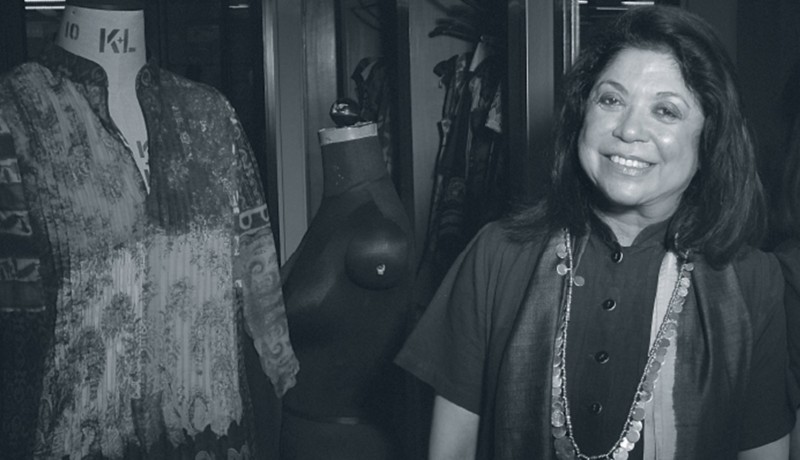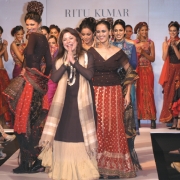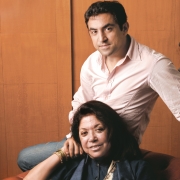
People

Drawing from traditional craft techniques to create contemporary chic, Ritu Kumar was a pioneer in the Indian fashion industry. And even after four decades in a notoriously fickle business, she remains heads and hemlines above the competition, writes Arati Rajan Menon
Tell me what you think,” says Amrish Kumar, as he spritzes some perfume on the inside of my wrist. The Tree of Life comes in a gorgeous bottle; clean lines with a floral motif lightly printed on the glass; a crimson, tasselled pump that channels red-carpet glamour. The scent, though, when it wafts its way up, is distinctly earthier, even primal; redolent of wet earth, dark woods, green grass, and the sandalwood sachets that kept silk saris fragrant in old steel trunks.
It’s exactly how you expect a fragrance from the House of Ritu Kumar to be — inimitably Indian. She wouldn’t have it any other way. “I told my son [Amrish], who helped develop the perfume, that it should have ingredients like khus, jasmine and sandalwood,” says the 63 year-old designer, who will launch the fragrance in stores this month. “After all, an Indian perfume must smell of India.”
Ritu Kumar’s India is vivid, a riot of textures and colour. A neon-orange banister leads the way up to her office in Gurgaon, an astonishing counterpoint to the art casually placed everywhere — a large kalamkari depiction of The Tree of Life, an exquisite old door, framed embroidery, works by artists Paritosh Sen, Jogen Chowdhury and Lalu Shaw, and even an imposing grey-black bull by Satish Gujral. Inside her office, the effervescence of the exterior is replaced by an enveloping calm, with russet tones of art by Anjolie Ela Menon and Shakti Maira and heavy jute blinds that keep the afternoon sun at bay. Sporadic flashes of colour come from the rack of garments in one corner, the textiles piled in a glass-fronted cupboard, and the fabric crammed in the bags lying askance on an embossed leather sofa.
“It’s khadi,” says Kumar, resplendent in an indigo silk tie-dyed salwar kameez set off by a necklace of silver coins. That’s her next project: a collection for the Rajasthan government. This month, she will visit towns like Jaisalmer, Barmer, Bundi and Jhalawar to check out the weaves available. When ready, the khadi line will be sold out of Rajasthan Handloom’s retail outlets at competitive prices. Kumar, featured in Harmony’s first Hotlist of silver achievers (in January 2005), believes in the need to take traditional industries beyond the status of folk art and make them ‘aspirational’ to keep them alive. “We have such beautiful fabrics; we just need that little extra effort to cut them better and make them more flamboyant,” she adds, her warm, lived-in face creasing into a wide smile. “I have managed to do it well sometimes, so I’ll give it a bash again!”
That’s almost laughably modest. A former art history student who was at the vanguard of the craft and textile revivalist movement in the 1970s with historians Pupul Jayakar and Kamala Devi Chattopadhyay, Kumar went on to develop a design vocabulary that draws from traditional techniques such as zardozi, bandhani, block-printing and chikan work to create contemporary chic in cotton, silk and leather. Beginning with four hand-block printers and two tables in Calcutta, she introduced the ‘boutique culture’ in India under the brand name ‘Ritu’ — she opened the first boutique in Delhi in 1966, in Calcutta in 1968, and in Mumbai in 1974. She’s dressed “well, just about everyone”, from Princess Diana and Jemima when-she-was Khan to Shabana Azmi and Sushmita Sen; in fact every Miss India winner from 1994 (“four girls a year for 14 years!”). Her fashion empire continues to grow, with over 20 boutiques in Delhi, Mumbai, Kolkata, Chennai, Amritsar and Chandigarh and a store in New Jersey (opened in October 2007). On the anvil are stores in Pakistan and Sri Lanka.
Ritu will always be 10 paces ahead of everyone else,” says Laila Tyabji, designer, writer, and founder member and chairperson of Dastkar, a society for crafts and craftspeople based in New Delhi. “She broadened the spectrum for design by interpreting traditional techniques in contemporary garments. She also popularised the bridal jora or lehenga. Earlier, people wore saris at their wedding.” Tyabji recalls an exhibition Kumar held at the Lalit Kala Akademi in the late 1970s. “She combined elements like zardozi, embroidery, block-printing and kalamkari with such style. It was an eye-opener to see that it could be done, and could be viable commercially and not just from a revivalist point of view.”
Her commercial status has been, admittedly, gratifying, but Kumar insists that her motivation was simple: patriotism. After studying at Lady Irwin College in New Delhi, in the mid-1960s she was selected for a scholarship to Briarcliff College in Westchester County, New York to study the history of western art. “There, my teachers would repeatedly refer to India’s rich cultural heritage,” she recalls. “I was dismayed to realise that I didn’t know about my own country. I was culturally impoverished.” Following her return to India, and her marriage to Shashi Kumar, a businessman, she moved to Calcutta — where she promptly enrolled herself in a diploma in museology. “I began to educate myself,” she says.
It was the start of what she calls “an exciting journey with long searches” — it would take days, sometimes years, touring through villages to discover artisans skilled at forgotten techniques. For instance, in the early 1970s, Kumar discovered the embroiderers of Ranihati, a settlement based outside Calcutta, and provided them with a workspace in their own environment. Gradually, the craft of zardozi, which flourished in the times of the Mughal emperors, was revived. “This is what drives me,” she says. “There are times I run out of energy. But then I think of the difference my business has made to so many, especially women. With this comes a responsibility to keep the business going.”
Still, Kumar has her share of reservations about the fashion business these days. “There are so many fashion weeks now but who are we really catering to?” she questions. “People seem to be designing just for the shows and not real people. From Chandigarh to Chennai, what are most people really wearing?” The answer, in her words, is salwar kameez. “This is India’s fashion,” she says with passion. “We have fantastic clothes, fabulous fabrics. But we’re going crazy about foreign brands in a reckless binge of consumption.”
Indeed, with the influx of foreign luxury and high-street brands, Kumar concedes it’s becoming harder for Indian designers to stay afloat. “So many people are coming into this market and consumers have deep pockets,” she says. “They don’t think twice before shelling out for a Gucci or LVMH product. Indian designers have to sharpen their pencils if they are going to compete,” she adds, a frown creasing her brow.
Designer Rohit Bal doesn’t think she needs to worry. “There’s always place for someone like Ritu Kumar,” he says, calling her a “pioneer” in creating a house of fashion in India. “There are many funky young designers but they are not a patch on her. While they remain in a mad urgency to create something trendy, she creates timeless pieces of art. She will always be relevant.”
But Kumar is nothing if not a realist — to stay ‘relevant’ in today’s market, she realises that she has no choice but to diversify. The launch of the fragrance is just the next step in the process that began with the creation of Label, her “younger, fashion-oriented line with an international feel” in 2002 that serves up jeans, trousers and tops, alongside the couture lines comprising saris and salwar kameez. “It is still identifiable to India, yet contemporary,” she says. “I don’t want to make black Lycra dresses or white T-shirts with our logo. But we needed to do this or we would have been completely left out.”
Driving the change has been 31 year-old Amrish, who joined the company in 2002 — her other son Ashvin is a filmmaker. “I think I needed someone like him to come and shake things up,” she says. Amrish’s goal is to build a diversified, international brand. “I don’t think Indian customers are as heterogeneous as they used to be,” he says. “We are much more part of the global village, more homogenous. So we have to look beyond the salwar kameez.” But he’s quick to add, “It’s important that the company remains steeped in our heritage. We are not a nation of blacks and greys; we wear more colours than anyone. It is important to take forward the vibrancy and romanticism of our culture.”
Kumar never expected Amrish to join the business. “You can’t push someone into anything,” she maintains. “But I’m glad he’s here. He handles all the business details and is great support.” For his part, Amrish calls his mum “magnificent”. “She’s always been a rock,” he says. “It’s always been easy to talk to her about our aspirations, our ideas. Of course, her strong points are not things of a more practical nature; that comes from my father’s side. He’s the grounded one.”
Kumar too relies heavily on husband Shashi — “a quiet person who shies away from the public eye”. He runs Kalamkari, a garment export house established in 1975, which she designs for. “The revenue helped drive my projects, like block-printing that never made any money initially,” she says with a chuckle. “I told him I’d make silly polka dot dresses for him as long as he let me carry on with what I loved.”
Today, Kumar is gearing up to pass on the mantle to Amrish. And what would she like to do? “Write another book.” Her first, Costumes and Textiles of Royal India, published by Christie’s in October 1999 chronicles the history of India’s royal patronage to textile arts, from Mohenjodaro to the present. “Our industry needed a reference point,” she says. In Kumar’s view, lack of documentation and archiving has been a major lacuna. “If I had to look for an old Indian fabric, I had to go to Victoria and Albert Museum in London.” Her next book would be about the crafts in India, “a story that must be told”.
Art is another passion for Kumar, who says she would have been a painter if she wasn’t doing what she is. “I do oils, I sketch,” she says. “In fact, I paint all my textile prints in my studio first.” She also enjoys gardening; loves classical music (her sons and she are trained vocalists); watches “every kind of cinema”, although Satyajit Ray is a favourite; works out regularly (cycling and yoga three days a week); and adores travelling, especially vacations off the beaten track in Ladakh and in wildlife sanctuaries. Kumar is always on the move — and loves it. In fact, there’s a palpable restlessness about her, evident during our photo-shoot; she’s eager to get it over with and get on with the rest of her day.
“Ritu has a huge appetite for life” says Tyabji. “While she actively fosters the arts, she genuinely cares for people. She is not at all pompous about what she does. And her home is a warm, informal place where she serves up good food and better company.” Kumar lives with her family in a sprawling farmhouse in Bijwasan village, a 15-minute drive away from her office in Gurgaon. She also has homes in Kolkata — where she lived until she moved to Delhi in the late 1970s — and Goa, where she “loves looking at the sea” as it brings out the more spiritual side of her. “I don’t feel that I am terribly religious,” she confesses. “But I do feel there is a greater power. It’s like I’ve got onto a boat and it’s taking me down some sort of river. I could try and negotiate it but it’s not something that I can completely control. Something is driving that boat.”
The contemplative frame of mind continues as she speaks of coping with the pressures of ageing. “There comes a time when you have to reassess your life and realise that you are less needed by your children,” she says with candour. “It happens to everybody; depression, a lack of motivation.” To beat the blues, she says silvers must find something that stimulates them, “something your very own, unrelated to your family”.
We can empower ourselves in the simplest ways, believes Kumar. She cites the example of her mother who, even in her 60s and beyond, would dress in her finest saris and jewellery every evening, even just to stay home. “When I once asked her why she was taking all the trouble, my mother replied, ‘I don’t want to grow old looking like Mrs Thatcher!’” recalls Kumar with a guffaw. “It made her feel good about herself. She may not have been a size zero but she looked fabulous.”
She rues the fact that the European mindset, which seems to have pervaded India, teaches us to be dissatisfied with our bodies. “Further, the whole business of fashion is so discriminatory for an older person,” adds Kumar, who describes her own personal style as driven by comfort — she wears Indian designers Meera and Muzzaffar Ali, Abraham and Thakore and Rajesh Pratap Singh; and western high-street brands MaxMara and Joseph.
To best the fashion mafia, Kumar believes women must trust their instincts and evolve their own style. “Enjoy the retail experience and buy nice things but don’t be a fashion victim,” she cautions. “Don’t try to look like Aishwarya Rai; that’s just not going to happen! Just enjoy yourself the way you are, the size you are, and the age you are.”
SIGNIFICANT AWARDS
2008: Chevalier des Arts et des Lettres (Knight of the Order of Arts and Letters) by the French Government; in recognition of her contribution to Indian textile crafts, and traditional techniques
2007: Indira Gandhi Priyadarshini Award; for her achievements and contribution in the field of fashion
2004: Designer of the Year at the F Awards in Mumbai
1998: Lifetime Achievement Award by the National Institute of Fashion Technology
1998: Outstanding Woman Entrepreneur Award by PHD-Chamber of Commerce
Photo: Shivay Bhandhari Featured in Harmony – Celebrate Age Magazine July 2008
you may also like to read
-
For the love of Sanskrit
During her 60s, if you had told Sushila A that she would be securing a doctorate in Sanskrit in the….
-
Style sensation
Meet Instagram star Moon Lin Cocking a snook at ageism, this nonagenarian Taiwanese woman is slaying street fashion like….
-
Beauty and her beast
Meet Instagram star Linda Rodin Most beauty and style influencers on Instagram hope to launch their beauty line someday…..
-
Cooking up a storm!
Meet Instagram star Shanthi Ramachandran In today’s web-fuelled world, you can now get recipes for your favourite dishes at….









